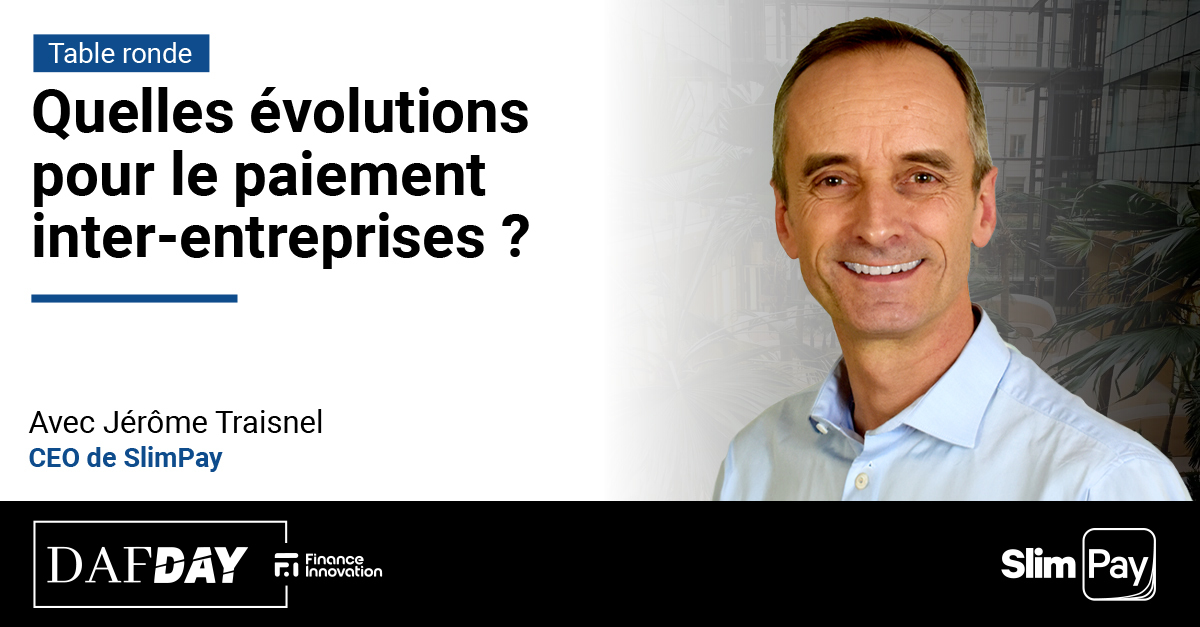We were present at the first Daf Day exhibition organized by Finance Innovation, which took place at BPI’s offices in Paris.
Daf Day, a full day of conferences and networking for Financial Directors with key players shaping the Fintech industry, including SaaS software developers, banks, institutions, and PSPs.
Throughout the day, there were keynote speeches on various topics such as electronic invoicing, the convergence of banking and startups, securing financial operations, automating accounting processes, digitalizing recruitment, and, of course, payments. All these topics were related to the broader trend of digitization in financial management (DAF).
In this inaugural edition, we had the pleasure of participating in a panel discussion on inter-company payments alongside Adyen, GocardLess, and Allianz Trade, moderated by Finegan Advisory.
The objective of this panel was to provide an overview of the major challenges in both B2B and B2C payments and understand their future prospects.
Let’s now recap the main ideas discussed.
Inter-company payments: an ongoing challenge
In a previous panel on electronic invoicing, a significant point was made: “Every entrepreneur is the banker of the other,” given the significant payment delays in France. According to the Banque de France, the payment process between two companies takes 48 days end-to-end, causing concern for many companies that may not be financially strong enough to manage such long outstanding debts.
While payment used to be a concern primarily for technical experts, it has become more mainstream today due to the rapid growth of e-commerce and marketplaces. For e-commerce, payment optimization is critical as it can make or break the acquisition efforts. For merchants, this critical point translates to lost sales and missed revenue opportunities.
Payment solutions have transformed into a business lever rather than a cost center. Additionally, payment plays a central role in the development of marketplaces, as they need to ensure a smooth payment experience for both buyers and partners who rely on the marketplace to grow. All these stakeholders are interdependent, with payment being pivotal to their development.
Payment is crucial for B2B and B2C subscriptions
For businesses with recurring revenue models in B2B, payment methods have evolved. Today, practices differ from those of a few years ago, with subscription billing gaining popularity for its revenue predictability and its impact on reducing fraud.
Offering subscription services allows businesses to build long-term, mutually beneficial relationships, secured by increasingly sophisticated payment solutions. Moreover, the subscription model introduces different payment methods depending on the type of merchants and even the countries. This leads to the concepts of “push” and “pull” payments.
Let’s delve into the details:
- “Push” payments are initiated by the payer, who makes a payment request themselves. These are more common in B2C, such as online sports club memberships, streaming services, and also in B2B, like SaaS software subscriptions.
- “Pull” payments, on the other hand, are initiated by the payee and typically revolve around traditional invoice sending, which is paid by the payer later. This method is more prevalent in B2B transactions.
It’s worth noting that payment practices can vary by country. In France, push payments are more common for B2C services, while in Germany, bank transfers are commonplace for consumers.
Consumers make push payments by transferring funds from their bank accounts to the beneficiary’s account to settle their bills. In B2B, another payment method is the B2B mandate, which has the advantage of being irrevocable (except in cases of fraud). Once consent is given in the electronic signature of the mandate, the payment made cannot be disputed, just like in B2C.
This is a payment method that some Payment Solution Providers can implement. For example, we can discuss it further?
Controlling cash flow, the key to success
In the B2B sector, a common trend among businesses, especially in times of crisis, is the management of cash flow and the timing of reimbursements.
67% of small and medium-sized enterprises (SMEs) seek immediate cash flow. Liquidity has become more crucial than ever, and it requires appropriate technological systems.
SMEs often lack the necessary tools for short-term cash flow management. For larger companies, Open Banking is revolutionizing the payment landscape.
With nearly 65 million users expected by the end of 2024, this technological revolution, already widely adopted in Scandinavian countries, is spreading to Southern Europe. This is a belief we strongly hold at SlimPay.
Thanks to our recent partnership with Trustly, account-to-account payments are set to become the standard for future payments, with unparalleled security and native irreversibility, all within an integrated journey.
This approach will help combat fraud, a common concern for merchants, and address card limit issues for high-value purchases. Furthermore, Open Banking provides merchants with the opportunity to manage their cash flow, knowing precisely which buyers can pay, and improve handling of non-payers and fraud.
In conclusion, Open Banking represents the heart of the future for subscription and usage-based industry models, aligned with the strong trend of individualization. Each customer journey will be tailored, requiring customers to input their preferences only once, offering a personalized experience regardless of the merchant.




